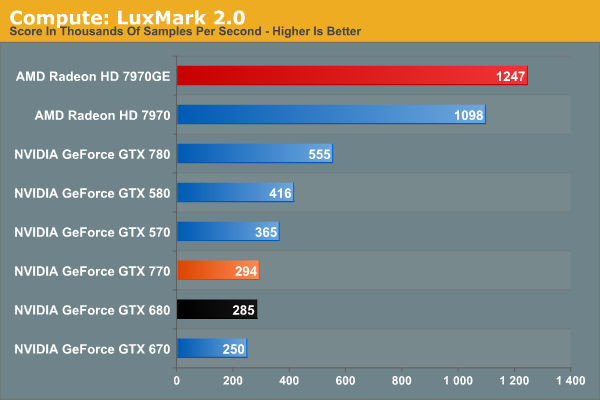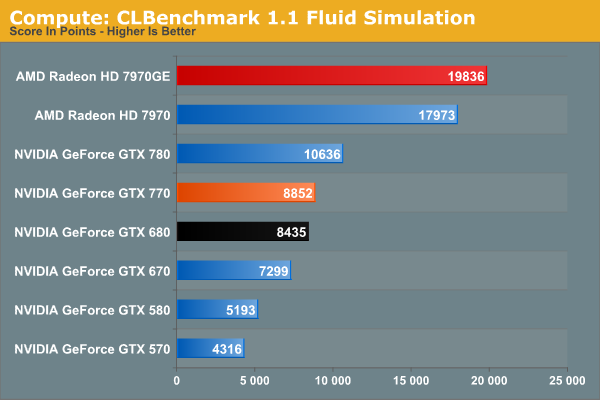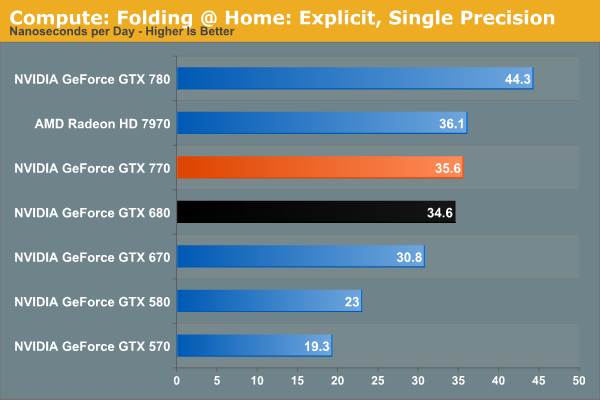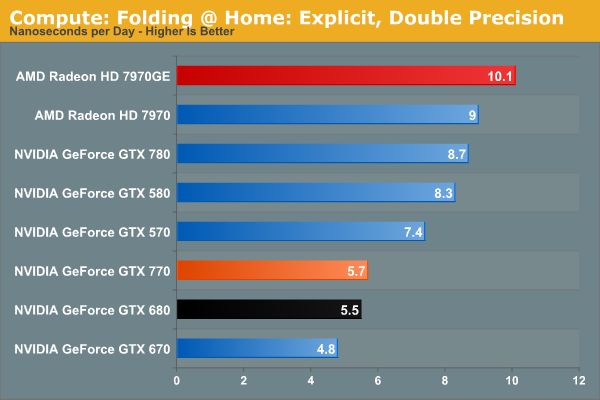NVIDIA GeForce GTX 770 Review: The $400 Fight
by Ryan Smith on May 30, 2013 9:00 AM ESTCompute
Jumping into compute, we aren’t expecting too much here. Outside of DirectCompute GK104 is generally a poor compute GPU, and other than the clockspeed boost GTX 770 doesn’t have much going for it.
As always we'll start with our DirectCompute game example, Civilization V, which uses DirectCompute to decompress textures on the fly. Civ V includes a sub-benchmark that exclusively tests the speed of their texture decompression algorithm by repeatedly decompressing the textures required for one of the game’s leader scenes. While DirectCompute is used in many games, this is one of the only games with a benchmark that can isolate the use of DirectCompute and its resulting performance.

Civilization V at least shows that NVIDIA’s DirectCompute performance is up to snuff in this case. Though as is the case with GTX 780, we’re reaching the limits of what this benchmark can do, due to just how fast modern cards have become.
Our next benchmark is LuxMark2.0, the official benchmark of SmallLuxGPU 2.0. SmallLuxGPU is an OpenCL accelerated ray tracer that is part of the larger LuxRender suite. Ray tracing has become a stronghold for GPUs in recent years as ray tracing maps well to GPU pipelines, allowing artists to render scenes much more quickly than with CPUs alone.

Moving on to a more general compute task, we get a reminder of how poor GK104 is here. GTX 770 can beat the slower GK104 products, and that’s it. Even GTX 570 is faster, never mind the massive lead that 7970GE holds.
Our 3rd benchmark set comes from CLBenchmark 1.1. CLBenchmark contains a number of subtests; we’re focusing on the most practical of them, the computer vision test and the fluid simulation test. The former being a useful proxy for computer imaging tasks where systems are required to parse images and identify features (e.g. humans), while fluid simulations are common in professional graphics work and games alike.


CLBenchmark paints GTX 770 in a better light than LuxMark, but not by a great deal. The gains over the GTX 680 are miniscule since these benchmarks aren’t memory bandwidth limited, and the gap between it and the 7970GE is nothing short of enormous.
Moving on, our 4th compute benchmark is FAHBench, the official Folding @ Home benchmark. Folding @ Home is the popular Stanford-backed research and distributed computing initiative that has work distributed to millions of volunteer computers over the internet, each of which is responsible for a tiny slice of a protein folding simulation. FAHBench can test both single precision and double precision floating point performance, with single precision being the most useful metric for most consumer cards due to their low double precision performance. Each precision has two modes, explicit and implicit, the difference being whether water atoms are included in the simulation, which adds quite a bit of work and overhead. This is another OpenCL test, as Folding @ Home has moved exclusively to OpenCL this year with FAHCore 17.


Recent core improvements in Folding @ Home continue to pay off for NVIDIA. In single precision the GTX 770 is just fast enough to hang with the 7970 vanilla, though the 7970GE is still over 10% faster. Double precision on the other hand is entirely in AMD’s favor thanks to GK104’s very poor FP64 performance.
Wrapping things up, our final compute benchmark is an in-house project developed by our very own Dr. Ian Cutress. SystemCompute is our first C++ AMP benchmark, utilizing Microsoft’s simple C++ extensions to allow the easy use of GPU computing in C++ programs. SystemCompute in turn is a collection of benchmarks for several different fundamental compute algorithms, as described in this previous article, with the final score represented in points. DirectCompute is the compute backend for C++ AMP on Windows, so this forms our other DirectCompute test.

Unlike our other compute benchmarks, System Compute is at least a little bit memory bandwidth sensitive, so GTX 770 pulls ahead of GTX 680 by 11%. Otherwise like every other compute benchmark, AMD’s cards fare far better here.










117 Comments
View All Comments
mapesdhs - Friday, May 31, 2013 - link
I've just bought two 3GB 580s for 450 UKP total, will be benching them next week
single & SLI. If you're interested in the results, let me know by PM/email (or Google
"SGI Ian" to find my contact page) and I'll send you the info links once the tests are
done. I'll be testing with 3DMark06, Vantage, 3DMark11, Firestrike, Call of Juarez,
Stalker COP, X3TC, PT Boats, Far Cry 3, and all 4 Unigines (Sanctuary, Tropics,
Heaven and Valley). If I'm reading reviews correctly, two 580s SLI should beat a 780.
If your existing 580 is a 1.5GB card, note you can get a 2nd one off eBay these days
for typically less than 150 UKP. I've won two this month, a Zotac card for 123 UKP
(using it to type this post) and an EVGA card for 142 UKP.
And yes, I agree, the new gen card pricing is kinda nuts. Anyone would think
we haven't had a recession. I doubt peoples' budgets have suddenly become
30% higher (only reason I could buy some is I sold some of my other stuff to
cover the cost). The two 3GB 580s I bought were in total 100 UKP less than the
cheapest 780 from the same seller (I probably could have eventually obtained
two 3GB 580s off eBay, but decided the chance to get them from a proper
retailer right now with warranty, etc. was too good to pass up).
Ian.
colonelclaw - Saturday, June 1, 2013 - link
Thanks for the reply, Ian. For some reason I'd totally forgotten about SLI. I'd be very interested to see the results of a 580 SLI vs. 780, and I suspect a few other readers here would too. One thing, how closely matched do the two cards have to be? Exactly the same model? Just the same clock speeds? Or is it more forgiving? I can't imagine it would be very easy to track down a 2nd identical 580, which is the reason I ask. If any Anand readers with knowledge of SLIing can share their experiences that would be great.shompa - Friday, May 31, 2013 - link
Memory... How many games are 64bit? = How many games needs more then 4gig memory? Today zero. It was even more fun when most PCs had BIOS. It cant even address that much graphic memory.Maybe 64bit gaming will be mainstream in a year? I don't know. I sure seems to take its time. I have used 64 bit in my work since 1995 (real computers) and 64bit on my mac since 2002. (OSX 10.27 Smeagol). Gaming/Windows takes its time since Windows don't have smart software packaging. (real computers have the same binary for 32/64bit, different languages and even different architectures. I loved when Apple had "fat binaries" and everything could run on both PPC and X86. Gives the customer a choice of architecture.)
SymphonyX7 - Friday, May 31, 2013 - link
Looks more like a GTX 680 Plus. The gains over the year-old GTX 680 and HD 7970 Ghz edition are measly and power efficiency was thrown in as an afterthought.I'll wait for the HD 8950 and HD 8970 or whatever they'll call it before I make a decision. I suppose it's worth the wait considering what implications the new PS4 and Xbox One will have on game development and their impact on PC ports performance-wise.
kwrzesien - Monday, June 24, 2013 - link
4GB models have appeared at Newegg: http://www.newegg.com/Product/Product.aspx?Item=N8...Colin.B - Tuesday, July 9, 2013 - link
I just ordered the Gigabyte GTX 770, sold one of my 660 SCs for 160 dollars and am returning the one I just bought. Will I see a big performance drop from 660 SLI to the 770 at 2560x1440? I hope I made the right choice :/